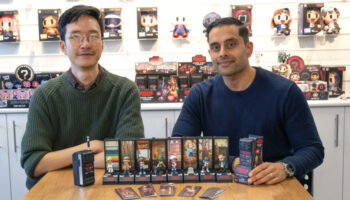As TinkerTini turns five, founder Trina McFarland discusses one thing that matters above all else

TinkerTini’s going to be five this year! Congratulations… You recently had a bit of a rebrand. What brought that on?
Thanks for noticing! TinkerTini grew up quickly and we’ve been busy! We finally had the bandwidth and resources to circle back to give our logo, website and now our Tinkerly platform some well-deserved love and focus.
What are the main changes?
For starters you can now read the Tini in the TinkerTini logo! Originally, we thought it was funny to make the Tini of our logo literally ‘teenie’ but – alas – our sense of humour resulted in us being called “Tinker” because people didn’t notice the Tini.

Ha!
Also, for our website, we’re sharing more of our results and will continue to update this as more inventor concepts make it to shelves… It’s hard to wait sometimes. What we worked on up to two years ago will launch soon. Our clients are doing a wonderful job engaging inventors on their business. We’re very proud of the work we’ve accomplished together and what’s to come. We’ve also outlined our inventor on boarding process, and put together a helpful TinkerTini FAQ.
And how are things on the Tinkerly platform?
On the platform, I’ve been overseeing the next evolution of Tinkerly 2.0. The branding was the fun part… The hard part was – and will always be – the software, workflows, search logic and thinking through the user roles with both inventor and company decision-maker needs in mind.
Right…
I’ve been studying how people make decisions when it comes to inventor concepts most of my career. Some think it’s a numbers game. Some say it’s luck. To me, there’s an element of pattern recognition that takes an experienced brain in this business with archival knowledge to be able to identify a concept with timely promise. But I think with the right technical assistance and knowing how to prompt it, anyone can have a better toy brain when it comes to making decisions, identifying something special at the perfect time, and then the structure to manage it to the finish line. That’s what I’m focused on. A new solution and approach to that process happening behind closed doors that will increase the odds for everyone.

And what was the motivation to build Tinkerly 2.0?
AI and tech-assisted is clearly where we’re all headed. With limited resources, TinkerTini’s been pulling an incredible amount of IR responsibility and doing it well, with results. I say that respectfully, with industry colleagues in mind because we’re all working hard within the constraints and cultures we are placed in… But because TinkerTini was the first to manage IR cross-company, it forced us to develop different tools and methods, cultivated from this unique experience.
Our experience would be hard to replicate within an organisation. It takes a semi-crazy person – that’s me – to venture into the wild to explore those limits. And we did. And I think we figured it out. We’re clearly doing something differently that’s working… So we decided to invest in exploring that more. I think the future state is knowing how to prompt and drive tech assists and AI. It’s what we’ve been doing this whole time at TinkerTini, and why we’re so efficient at what we do.
I’m interested, then: what was it like building the platform?
Challenging! I never intended to move into the software-development space, and it’s not my area of expertise… But it’s where my path led me; I’ve had to learn quickly. I’m excited about what we are creating, and hope it’ll solve some problems in the industry for both companies and inventors.
To what end? What’s the goal?
The goal is a more sustainable and diverse shared resource: our global inventing community. And one that is around for generations to come. It’s going to take a village to ask some hard questions about our methods and value systems. We need to take an honest look at our past IR/pro-inventing culture, how we got here and where we want to go from here. I think this work starts now, and it’s already begun.

In the past, Trina, you’ve written extensively about the lessons you’ve learned as an entrepreneur. Five years in, what are the big three?
I only have one now: Do it for the right reasons. The second you start living your life or running your business for or based on recognition from others, you start to lose your footing. It’s easy to get sucked into this in the toy business. Let your work speak for itself. Focus on that above all else…
If you’re on your path, in your element, grounded by genuine passion and love for what you do, you’re winning. You don’t need any person or organisation to tell you otherwise. That power belongs to the individual when we’re talking about entrepreneurs, small-business owners and inventors. They need to hear that more often. You only answer to yourself at the end of the day. That can’t be avoided. Everything else can be. Do it for the right reasons.
–
To stay in the loop with the latest news, interviews and features from the world of toy and game design, sign up to our weekly newsletter here

























